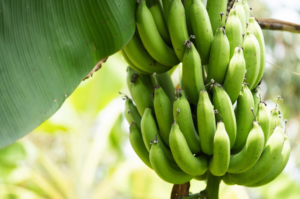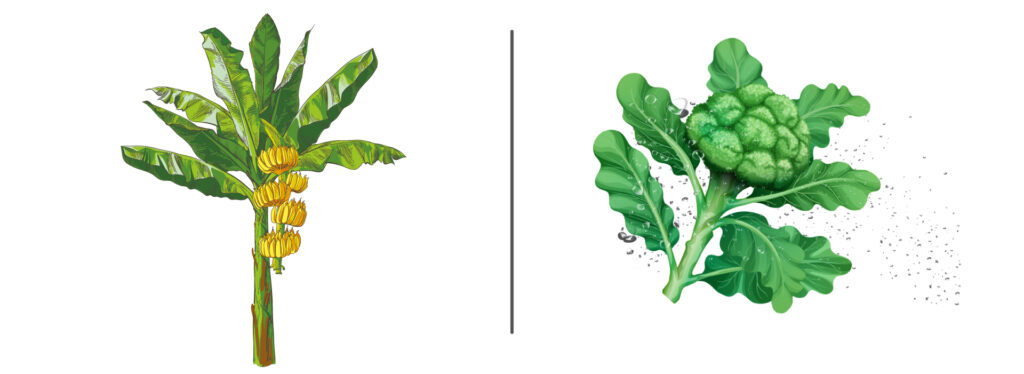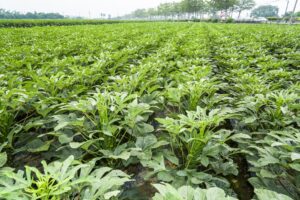
Efficacy of Jaque Mate on Bananas
Date: July – December 2018 Goal: To determine the feasibility

JAQUE MATE is a protectant foliar fungicide for use in organic production that controls soil-borne plant diseases such as Pythium, Rhizoctonia, Phytophthora, Verticillium, Fusarium and others. It also suppresses/controls foliar diseases such as Powdery and Downy Mildew, Greasy Spot, Otrytis, Sclerotinia, Alternaria, and others.
JAQUE MATE also works as a fungicide seed treatment. No re-entry interval required.
Uses
A broad variety of crops including Wheat, Alfalfa, Pastures, Field corn, Sweet corn, Soybeans, Beans, Peas, Sorghum, Oat, Sugar cane, Vegetable Root Bulb or Tuber crops (Potatoes, Onions, etc.) Tomatoes, Peppers, Leafy vegetables (Lettuce, Spinach, Cauliflower, Broccoli, etc), Cucurbits (Melons, Watermelon, Squash, Zucchini, etc.), Table Grapes and Wine Grapes, Strawberries, Blueberries, Blackberries, Raspberries, Cranberries, Kiwi, Pome Fruits (Apples, Pears, etc.), Stone fruits (Plums, Nectarines, etc.) Citrus, Avocadoes, Rice, Asparagus, Okra, Nut crops (Peanuts, Almonds, Walnuts, etc), Olives, Ornamentals, Landscape
Use Rate
6 – 8oz/ac
Jaque Mate has antifungal action by provoking an imbalance in calcium and hydrogen, affecting gene transcription regulation, disruption of cell membrane integrity, and ergosterol biosynthesis (Ahmad et al., 2011).

| Crop | Pest | Rate (L / 200 L water) | Observations |
|---|---|---|---|
| Banana | Black Sigatoka (Mycosphaerella) | 0.25 to 0.5 l/ha | A block of two continuous applications is recommended. Apply with a water volume that allows maximum application coverage. The use of a coadjuvant that favors the coverage of the application is recommended. Do not apply at a severity of more than 10% of the disease. |
| Specialty and row crops, including: Corn, Soy Beans, Leafy Vegetables, Cucurbits, Berries, Grapes, Potatoes, Onions, Pineapples, Fruit and Nut trees | Anthracnose (Colletotrichum spp.), Blight (Alternaria spp., Phytophthora spp.), Downy mildew (Peronospera sp.), Powdery mildew (Peronospera sp.), Powdery mildew (Peronospera sp.). (Peronospera sp.), Powdery Mildew (Pseudoperonospora sp.), Rust (Hemilia vastatrix), Cercospora spp. Cercospora spp, Ascochyta pisi, Botrytis spp, Septoria sp, Albugo candida, Rhizoctonia solani and others. | Preventative without incidence 0.25 to 0.35 l Preventative with incidence 0.35 to 0.50 l |
Specialty and row crops, including: Corn, Soy Beans, Leafy Vegetables, Cucurbits, Berries, Grapes, Potatoes, Onions, Pineapples, Fruit and Nut trees
Anthracnose (Colletotrichum spp.), Blight (Alternaria spp., Phytophthora spp.), Downy mildew (Peronospera sp.), Powdery mildew (Peronospera sp.), Powdery mildew (Peronospera sp.). (Peronospera sp.), Powdery Mildew (Pseudoperonospora sp.), Rust (Hemilia vastatrix), Cercospora spp. Cercospora spp, Ascochyta pisi, Botrytis spp, Septoria sp, Albugo candida, Rhizoctonia solani and others.
0.25 to 0.5 l/ha
A block of two continuous applications is recommended. Apply with a water volume that allows maximum application
coverage. The use of a coadjuvant that favors the coverage of the application is recommended. Do not apply at a severity of more than 10% of the disease.

Date: July – December 2018 Goal: To determine the feasibility

Date: July, 2019 Goal: To validate the efficacy and profitability
WE WANT TO HEAR FROM YOU
WE’VE BUILT OUR BUSINESS ON HARD WORK AND TRUST, BY LISTENING TO FARMERS FOR MORE THAN 20 YEARS.